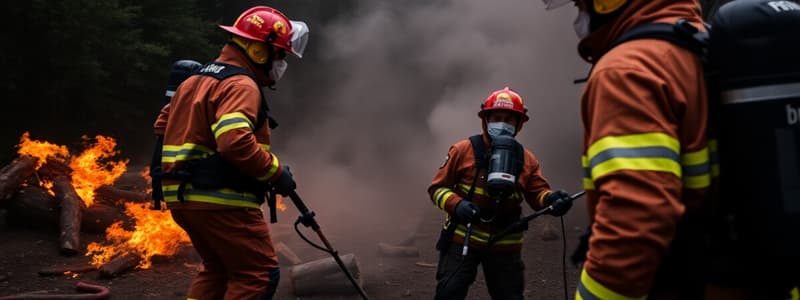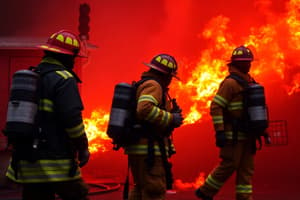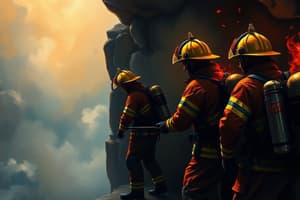Podcast
Questions and Answers
What balance is crucial for a primary search to be effective?
What balance is crucial for a primary search to be effective?
- Efficiency and silence, to avoid alarming potential victims.
- Speed and efficiency, ensuring a systematic approach. (correct)
- Thoroughness and communication, maintaining constant radio contact.
- Speed and thoroughness, prioritizing victim contact above all else.
What is the primary goal of a primary search during a fire?
What is the primary goal of a primary search during a fire?
- Securing the building's perimeter to prevent further spread.
- Finding and removing occupants from danger. (correct)
- Locating the fire's origin to inform suppression efforts.
- Assessing structural integrity to ensure firefighter safety.
According to the information, where are victims most commonly found during search and rescue operations?
According to the information, where are victims most commonly found during search and rescue operations?
- Hallways
- Bedrooms (correct)
- Family rooms
- Bathrooms
Why is staying oriented crucial during search operations?
Why is staying oriented crucial during search operations?
When using a Thermal Imaging Camera (TIC) during a primary search, how should it be employed to maximize its effectiveness?
When using a Thermal Imaging Camera (TIC) during a primary search, how should it be employed to maximize its effectiveness?
What is the significance of understanding departmental terminology regarding search tactics?
What is the significance of understanding departmental terminology regarding search tactics?
What is the main advantage of a split search technique?
What is the main advantage of a split search technique?
In a Vent, Enter, Search (VES) operation, what is the purpose of isolating the room after entry?
In a Vent, Enter, Search (VES) operation, what is the purpose of isolating the room after entry?
During a Wide Area Search, what is the primary purpose of using a rope or tagline?
During a Wide Area Search, what is the primary purpose of using a rope or tagline?
What is the recommended approach regarding communication during a search?
What is the recommended approach regarding communication during a search?
What is the key consideration when deciding whether to stay on the wall during a search?
What is the key consideration when deciding whether to stay on the wall during a search?
What should members of a search team do to stay oriented inside a structure?
What should members of a search team do to stay oriented inside a structure?
If a search team locates a fire while searching for victims, what is their next priority?
If a search team locates a fire while searching for victims, what is their next priority?
What role does the team lead play in an oriented search?
What role does the team lead play in an oriented search?
In the context of search operations, what does 'actionable data' refer to?
In the context of search operations, what does 'actionable data' refer to?
When performing a wide area search, what action should crews take when exiting the structure?
When performing a wide area search, what action should crews take when exiting the structure?
What is the purpose of 'hook and look' during the 'move to the doorway' step of a VES operation?
What is the purpose of 'hook and look' during the 'move to the doorway' step of a VES operation?
How does prior knowledge of a building's layout contribute to the effectiveness of a primary search?
How does prior knowledge of a building's layout contribute to the effectiveness of a primary search?
What is one purpose of the initial scan with a TIC when entering a structure?
What is one purpose of the initial scan with a TIC when entering a structure?
What should a team lead do at the door/threshold of a room during an oriented search?
What should a team lead do at the door/threshold of a room during an oriented search?
Flashcards
Primary Search
Primary Search
Finding and removing citizens from harm during a fire.
Efficient Primary Search
Efficient Primary Search
A rapid and systematic search approach, balancing speed and efficiency.
Common Victim Locations
Common Victim Locations
Most often in bedrooms (45%), then hallways (9%), bathrooms (6%), and family rooms (16%).
Search Team Orientation
Search Team Orientation
Signup and view all the flashcards
Hoseline Placement
Hoseline Placement
Signup and view all the flashcards
Fire Location Reporting
Fire Location Reporting
Signup and view all the flashcards
Search Prioritization
Search Prioritization
Signup and view all the flashcards
Search Size-Up
Search Size-Up
Signup and view all the flashcards
Oriented Search
Oriented Search
Signup and view all the flashcards
Split Search
Split Search
Signup and view all the flashcards
Window Initiated Search
Window Initiated Search
Signup and view all the flashcards
Wide Area Search Anchoring
Wide Area Search Anchoring
Signup and view all the flashcards
Wide Area Search
Wide Area Search
Signup and view all the flashcards
Wall Anchored Search
Wall Anchored Search
Signup and view all the flashcards
Study Notes
- Fire departments aim to protect and save lives.
- Firefighters remove citizens from dangerous situations.
- The primary search finds and removes citizens from harm.
- A primary search can happen while suppressing a fire.
- These searches should be fast and systematic while balancing speed and efficiency.
- Knowledge from dispatch, structure familiarity, and bystander info from solid search size ups should be used to "get where we are going" as soon as possible.
- Primary searches are completed in high stress or zero visibility conditions.
- Thoroughly search all occupiable areas while prioritizing known victim locations as quickly as possible.
- Firefighter Rescue Survey actionable data provides verifiable information on where citizens are most often located.
- Victims are most often found in bedrooms (45%), hallways (9%), bathrooms (6%), and family rooms (16%).
- Search is an assignment.
- The crew decides on a strategy to achieve strategic goals based on data, training, experience, departmental policy, and common sense.
- Clackamas Fire District #1 Rescue and Search document and Insight Training LLC on Tactical TIC use are helpful resources.
Primary Search Tactics
- All search team members should stay oriented inside the structure.
- If searching without a line, a charged hoseline should be between fire and the search crew.
- Fire room is isolated to ensure that the search is viable based off real time information.
- If fire is located while searching for victims, isolate the fire room and relay its location to fire attack.
- Talking during a search should be kept to a minimum.
- Communication should remain pertinent, to avoid distracting from victim sounds.
- Once found, keep victims as close to the ground as possible.
- Prioritize areas with a high likelihood of finding victims.
- Scan a room with TIC for victims and fire location before entry, if applicable.
- If using a TIC during a search, it should not be used while moving through the structure.
- The TIC should be used for an initial scan to identify doors/windows for victim removal or emergencies.
- Ensure all members of the search team are briefed and understand the plan.
Oriented Search
- One member runs the team and coordinates search.
- They will maintain location awareness and accountability
- The team lead can:
- Stay at the door/threshold of a room and act as a waypoint
- If team lead has a TIC, he/she can quickly scan the room and relay pertinent information to the searcher.
- Can sweep/search the immediate area.
- Pay attention to both positive and negative interior conditions.
- Maintain visual or voice contact.
Split Search
- This splits your crew allowing twice the amount of space to be searched.
- This reduces time in the structure and improves victim survivability chances.
- Crew splits into two teams to search two rooms that are close together.
- Each team completes a search of assigned area then continues moving to the next room/area.
- The teams can move independently of each other as long as they are in visual or voice contact
VES/VEIS / Window Initiated Search
- This tactic has undergone several name changes.
- It was initially called Vent, Enter, Search then was later changed to Vent, Enter, Isolate, Search.
- I have also heard people refer to the same tactic as Window- Initiated Search.
- All members should be on the same page and understand the tactics that are being implemented when these terms are utilized on the fireground.
Vent Enter Search (VES)
- Complete search size up and locate known or potential area/s with highest probability of victims.
- Take window/make access.
- Sweep area below window/sound floor.
- One firefighter enters room, and one stays outside or both firefighters enter room.
- If applicable utilize TIC to locate door to room and immediately identifiable victims.
- Move to the doorway of the room searching as you go, hook and look then come back in the room closing the door behind you.
- Finish searching room bringing victim/s back to window and remove from structure.
Window Initiated Search
- After completing a search size up, enter the room through a window to start a search.
- If unable to leave the room due to fire conditions, employ VES/VEIS tactics.
- If able to leave the room, continue search through the structure staying oriented to the entry point.
Wide Area Search
- Use on large structures/big box stores.
- Utilize an anchor point (outside the structure or IDLH environment)
- TIC improves wide area search.
Wide Area Search Tips
- Secure rope/tag line to stationary object outside the structure/IDLH environment and move inward.
- Stop and scan at intervals, focusing on identifying “landmarks".
- Members can leave a person anchored at the rope and search out from the anchor while staying in visual/voice contact.
- Monitor air consumption.
- Tie off rope and follow it back outside when exiting.
Staying Oriented During A Search
- Practice and confidently perform a search in an IDLH environment.
- Some feel comfortable coming off the wall while others move slower and focus on staying oriented to each other.
- Place a foot or feet against the wall while sweeping the area stretching out as far into the room as possible.
- Two searchers going in opposite directions can speed up a search but that is dependent on room size as it may be more expedient for one firefighter to search the room alone.
- If you are doing an “anchored” search and come across a victim or potential victim move off the wall to perform a rescue or investigate.
- Move right back to the wall after moving to investigate or help someone.
Studying That Suits You
Use AI to generate personalized quizzes and flashcards to suit your learning preferences.




